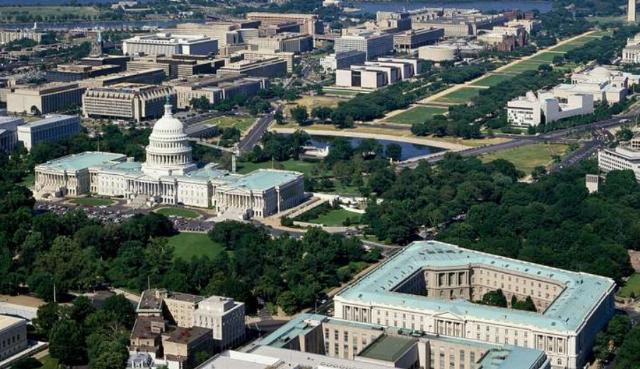

Photo Credit: Image via Picryl.
Picryl
Over the next four years, we must take many interconnected steps to modernize, shrink, and renew our system of government.Over the next four years, we must take many interconnected steps to modernize, shrink, and renew our system of government.
The Cost of Regulation
The cost to the country of inefficient federal regulations is stunning. The Competitive Enterprise Institute estimated several years ago that federal regulations imposed costs of over 1.2 trillion dollars. And this isn’t even half of the burden of the administrative state. Put another way, according to the Mercatus Center of George Mason University, the U.S. economy would grow by at least $4 trillion yearly with a lighter and more efficient regulatory burden.
Decentralization as an Alternative Model
Starting in 2025, we should return much of the power and authority of the national government to the flexibility of state and local governments and to the thousands of private civic groups that can respond effectively to state and local needs. The national government should apply this decentralized ethos by transferring, with rare exceptions, most of its regulatory authority to its state and local equivalents. In some cases, the states and localities may decide that a particular area, like school bus driver dress codes or the length of dog leashes in parks, no longer needs to be regulated by any government agency. If so, this specific administrative or regulatory power will end in that state.
Downsizing and Decentralizing
With broad authority to downsize, the president should require every department, agency, and bureau to recommend reducing and simplifying all of its regulations, budgets, personnel, and operations as a priority.
During his first term, the president would require every agency to reduce the number and scope of regulations by at least forty percent. Aside from the most critical defense, health, and safety operations, trimming the fat would be every agency’s prime four-year agenda.
By permanently downsizing an agency’s personnel, transferring tens of thousands of employees out of Washington, and dramatically reducing its responsibilities, the new reform administration would make this radical restructuring difficult for a subsequent administration to undo.
Working with Congress to Reduce the Legislative and Regulatory Burden
The 50 titles of the Code of Federal Regulations now comprise 90,402 pages.
The president should work closely with Congress, oppressed citizens, companies, and groups to eliminate vague, overlapping, and duplicative laws; repeal antiquated, intrusive, and onerous legislation; and simplify the entire Federal Code. The White House should prohibit new regulations except for dire emergencies.
Cost-effectiveness
The president should order that government regulations be revised to ensure that they are cost-effective. Agencies cooperating with congressional staff and non-governmental experts should redraft all relevant statutes with cost-impact guidelines. Regulations failing these guidelines should be withdrawn.
Economic Impact and Family-Friendly
As part of the reform effort, federal agencies must measure all laws and regulations by their impact on economic growth and prosperity. Except for emergencies, all new or revised regulations or policies would require a “growth and prosperity impact report” before they could go into effect. Regulations with a demonstrable negative impact would be shelved.
When relevant, federal agencies should also be required to measure all laws and regulations by their impact on families, particularly on family formation and stability. All new regulations or policies would require a “Family Impact Report” before they could go into effect. Regulations with a demonstrable negative impact should generally be banned.
As is the case with “Environmental Impact Reports,” a “Growth and Prosperity Impact Report” and a “Family Impact Report” would slow down new laws and regulations. The interest groups, progressives, activists, academics, and media acolytes of big government would need to adjust.
Sunsets
All new and revised regulations should also have a sunset clause or expiration date of five to ten years. Regulations that demonstrate their effectiveness would have five additional years before they sunset. Several states, including Arizona, have successfully employed sunsetting.
Goals and Timetables
All federal agencies should be required to have specific and measurable goals, performance timetables, and transparent budgets in this new era of government accountability. Most private-sector organizations operate with such accountability guidelines. The president’s Office of Management and Budget is well positioned to oversee such an initiative.
Failure to promptly meet the chief executive’s goals and budget constraints should lead to immediate negative consequences for the relevant management personnel, regardless of civil service status. Top civil service performers and their teams should be suitably rewarded. There should be generous rewards for the civil servants who cut the fastest and most efficiently while protecting essential services.
Deunionization
Congress should reform the federal workforce by prohibiting the unionization of federal workers. Specifically, President Trump should reverse President Kennedy’s dreadful overreach in authorizing this practice. This action would enable the president and Congress to pursue these reforms over the inevitable opposition of entrenched bureaucrats, unions, and lobbyist allies.
Federal Retirement
Employee salaries, health care, and pensions account for most federal government costs. Reformers must control these costs to manage the massive federal deficit.
Unless otherwise prohibited by law, all pensions of new federal civilian employees should be modified to “Defined Contribution” rather than “Defined Benefit.” All new federal employees, much like most private-sector employees, should contribute substantially to their retirement accounts. Federal contributions into federal employee retirement accounts should be the average of private-sector contributions.
The federal government should offer incentives to existing federal employees, such as promotions, travel and training opportunities, loans, onetime salary payments, and early retirement, to persuade them to convert their retirement plans to “Defined Contribution.”
The federal government should offer financial and other incentives to convert state and local pension systems to the “Defined Contribution” option to promote the long-term fiscal soundness of state and local governments.
Disability retirement has been abused in many government agencies over the years, so special care should be taken to ensure that such benefits go to workers who deserve these costly benefits.
Congress should propose an amendment to the U.S. Constitution to anchor these groundbreaking budgetary and reorganizational reforms for the foreseeable future.
Conclusion: The Deficit and Foreign Policy
The enormous federal budget deficit is driving the country toward a financial catastrophe. The new administration must enact dramatic reforms to prevent that catastrophe.
The next few decades are likely to be a time of international turmoil as the United States deals with the malevolent axis of China, Russia, Iran, and North Korea. The president and his closest staff must spend much of their limited time and energy dealing with this turmoil. The country will be better governed and more stable if state and local governments and the private sector broadly administer the burden of domestic policy.
James S. Fay is a semi-retired attorney, political scientist, writer, and college administrator. His articles have appeared in social science and law journals, the Wall Street Journal, the Los Angeles Times, and Real Clear Defense. He served as a U.S. Army intelligence officer in Germany. He has worked in both the public and private sectors.
<img a alt="
Image via Picryl.
” by-sa captext=”Picryl” cc gage gageskidmore href=”http://creativecommons.org/licenses/by-sa/2.0/legalcode” https: photos src=”https://conservativenewsbriefing.com/wp-content/uploads/2025/02/downsizing-the-federal-government.jpg” strong www.flickr.com>
Image via Picryl.






